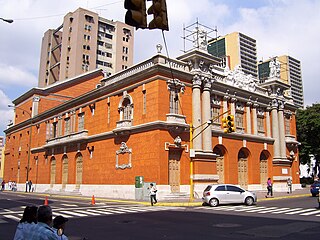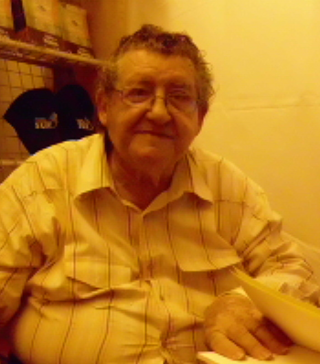Related Research Articles

Aquiles Nazoa was a Venezuelan writer, journalist, poet and humorist. His work expressed the values of popular Venezuelan culture.

Fredy Reyna was a Venezuelan musician, arranger and performer, regarded as one of the two masters of the Venezuelan cuatro, which he elevated to the level of a concert instrument, and one of his country's most important cultural figures in the 20th century.

El Teatro Baralt is a theatre in downtown Maracaibo, Venezuela, at the northwestern corner of the historic Plaza Bolívar. The first theatre at the site was built in the mid 19th century as a small performance hall, with subsequent theatre buildings there having seen many different reconstructions.
Mariano Díaz Bravo is a Chilean-born Venezuelan photographer, graphic designer and writer, best known for his contributions to the study and promotion of Venezuelan folk art. In 1993, he received the Premio Nacional de Arte Popular "Aquiles Nazoa", Venezuela's highest honor for folk artists and folk art promoters.

In Venezuela, since the opening of the Teatro Caracas and, earlier, the Teatro Maderero, there has been a great lyrical tradition ranging from serious opera to operetta, zarzuela, and Spanish musical reviews.

The cinema of Venezuela is the production and industry of filmmaking in Venezuela. Venezuelan cinema has been characterised from its outset as propaganda, partially state-controlled and state-funded, commercial cinema. The nation has seen a variety of successful films, which have reaped several international awards. Still, in terms of quality, it is said that though "we can point to specific people who have made great films in Venezuela [and] a couple of great moments in the history of Venezuelan cinema, [...] those have been exceptions". In the 21st century, Venezuelan cinema has seen more independence from the government, but has still been described as recently as 2017 to be at least "influenced" by the state.

The Teatro Nacional de Venezuela is a building and associated theatre company in Caracas. The theatre presents plays, operas and zarzuelas. It was re-named after Román Chalbaud shortly after the death of this Venezuelan film director, screenwriter and playwright.

Román Chalbaud was a Venezuelan film director, screenwriter, and prominent playwright. Starting work in television after prestigious training, Chalbaud moved into making films before the industry took off in his home country, returning to theatre where he had been a great success for several years until filmmaking became a viable industry. He served as the president of Venezuela's leading theatre, television, and film organisations.
The following is a timeline of the history of the city of Caracas, Venezuela.

The Palacio Federal Legislativo, also known as the Capitolio, is a historic building in Caracas, Venezuela which houses both the National Assembly and the National Constituent Assembly. Located southeast of the Plaza Bolívar, it was built between 1872 and 1877 by President Antonio Guzmán Blanco to a design by the architect Luciano Urdaneta Vargas. The Salón Elíptico, opened in 1877, is topped by a golden dome.

Correo de Carmelitas is a colonial building in Caracas, Venezuela, located in the historic center of the city on the corner of Avenida Urdaneta and Carmelitas street. It is located in the Cathedral Parish of the Libertador Bolivarian Municipality.

Bolívar Square in Caracas is one of the most important and recognized Venezuelan public spaces. It is located in the center of the first 25 blocks of Caracas when it was founded as "Santiago de León de Caracas" in 1567. It is in the historic center of the city in the Cathedral Parish of the Libertador Municipality.

That's the Woman I Want is a 1950 Venezuelan-Argentine comedy film directed by Juan Carlos Thorry and starring Olga Zubarry, Francisco Álvarez, Héctor Monteverde and Amador Bendayán. It was Thorry's directorial debut, though he had gone to Venezuela to act, and was commercially successful. The film has been analyzed as part of Venezuelan film history, in particular by Central University of Venezuela academic María Gabriela Colmenares.

The Basilica of Santa Capilla It is a Roman Catholic basilica in Caracas, Venezuela located at the corner of Santa Capilla on Avenida Urdaneta. It is located in the historic center of the city, in the Cathedral Parish of Libertador Municipality. On February 16, 1979 was declared a National Historic Landmark.
Gran Cine is a non-profit civil association founded on 13 June 1996. It functions as an alternative film distributor in Venezuela. The aims of the organisation are a rough group of objectives with the overall goal being to widen the reach of film, especially independent, diverse and global film, in Venezuela. It has a group of associated cinemas, used for exhibition and education.
Carlos Ruiz peleando con un cochero is a Venezuelan slapstick comedy film created by and starring Carlos Ruiz Chapellín and Ricardo Rouffet. It was first played in the Circo Metropolitano de Caracas on November 26, 1897.

Carlos Ruiz Chapellín was a Venezuelan showman, filmmaker and performer. He is remembered for creating slapstick comedy films in the late 19th century.
Venezuela was introduced to cinema as a for-profit industry in the 1890s, when the medium became international. There were at least eight national films made in the decade, by three groups of filmmakers — one of the groups was based in Maracaibo and one was based in Caracas. The first film screening in the nation may have taken place as early as 1894, but is generally reported as 1896, with this later date being the first scheduled public screening.
Venezuela had been introduced to cinema in the 1890s. After an initial boom in screenings and production, the presence of cinema in the nation was lower between 1900 and 1910.
References
- ↑ "Cine Aquiles Nazoa" (in Spanish). Archived from the original on 5 November 2014. Retrieved 5 November 2014.
- ↑ "Cine Aquiles Nazoa antiguo Cine Urdaneta" (in Spanish). Retrieved 5 November 2014.
- ↑ Festival de Teatro de Caracas (ed.). "Cine Aquiles Nazoa" (in Spanish). Archived from the original on 5 November 2014. Retrieved 5 November 2014.